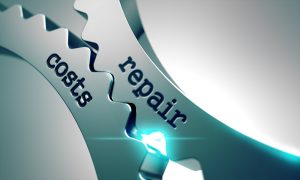The time needed for repair is one way to secure the efficiency of after sales services. But what is actually included in repair time and how it should be measured? And more importantly, what benefits can be gained through shorter repair times?
Repair time and efficiency
 The actual physical repair time is just a part of the whole repair process. Logistics, stocking, inventory and related activities take most of the time. The efficiency of the whole repair time (TAT) can be improved by shortening the actual repair time with systematic procedures, but also with other means. Lower inventories and accurate information to customer and R&D of the reason of failure are some examples of these.
The actual physical repair time is just a part of the whole repair process. Logistics, stocking, inventory and related activities take most of the time. The efficiency of the whole repair time (TAT) can be improved by shortening the actual repair time with systematic procedures, but also with other means. Lower inventories and accurate information to customer and R&D of the reason of failure are some examples of these.
A shorter repair time reduces costs and improves productivity. The sooner the broken parts have been repaired and installed back to use, the better. Products that are lying around waiting for repair need space and complicate other activities. This can be avoided with a well-managed repair process. A clear overview is visible and easy to keep clean and clear, which also influences on productivity. Also customers can see the difference.
How to shorten the repair times
In a nutshell, the key topics to focus on are the following:
- Removing waste time
- Improving processes
- Managing capacities
- Focusing on repair quality
- Securing material management
Removing waste time means that in the repair center all unnecessary steps must be removed. Products are clearly moving to next phase without delay. If the repair center’s repair time (from receiving to dispatching) is for example 20 days, most probably more than half of this time it is just ineffective waiting time.
Improving processes means strict process analyses which will help to improve both processes and practices. Bottle necks can be eliminated, when facts show where products to be repaired are unnecessarily lying. Clear process steps also help controlling the phase of the products in the process and knowing always what the next step is. Actual repair time in repair center is usually just from few minutes to few hours (+ possible environmental testing which can take longer time).
Managing capacities can be a challenge, if the work flow to the repair center varies. Sometimes the faulty stocks are full, sometimes empty. Ideally the customer and repair center plan and forecast together the capacities in order to reduce volume variation. Target of course is as stable volume flow as possible, because it is the most cost effective way.
For example, if the customer sends the faulty products seldom in larger units in order to reduce their delivery cost, this causes challenges to the efficiency (and cost) of the repair center. Therefore the total cost should be analyzed together: this way both parties win. Savings by collecting larger shipments might be in the end more costly due to the repair center capacity challenges. On the other hand, the outcome can be just the opposite. Total cost can be lower, but repair time increases – which also has its costs.
Focusing on repair quality prevents additional costs. This means choosing repair partners carefully: the repairs should be managed with high quality results in the first place. If repairs are not done carefully, the final testing fails… and the work has to be done again. Secondly high quality repairs perform better in use and avoid another failures. Responsible and skillful repair technicians and engineers are an asset for high productivity.
Securing material management prevents unnecessary waiting times. The repair process should not be prolongued due to component or even packing material shortage. Professional purchasing and materials management are important enablers of a smooth repair process.
